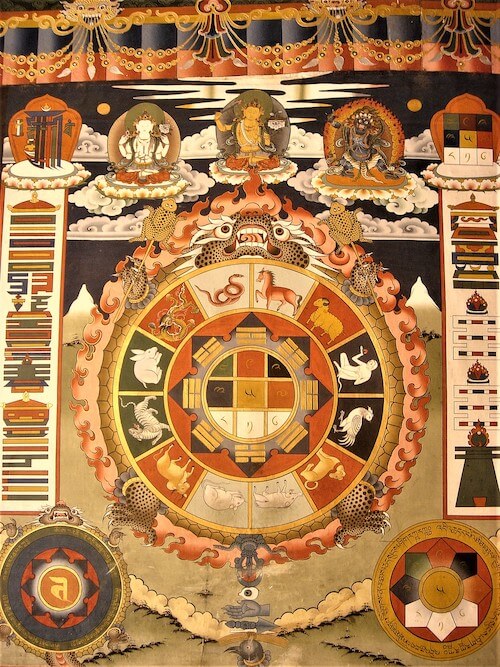 The Wheel of Life (called the ‘Bhavachakra’ in Sanskrit) is a symbolic representation of cyclic existence, found on the walls of Tibetan Buddhist temples and monasteries in the Indo-Tibetan region. This pictorial diagram presents the basic Buddhist concept of the cycle of birth, rebirth and existence in samsara (or cyclic existence). The Bhavchakra can be translated as ‘Buddhist Wheel of life’, ‘Wheel of cyclic existence’, ‘wheel of becoming’.
The Wheel of Life (called the ‘Bhavachakra’ in Sanskrit) is a symbolic representation of cyclic existence, found on the walls of Tibetan Buddhist temples and monasteries in the Indo-Tibetan region. This pictorial diagram presents the basic Buddhist concept of the cycle of birth, rebirth and existence in samsara (or cyclic existence). The Bhavchakra can be translated as ‘Buddhist Wheel of life’, ‘Wheel of cyclic existence’, ‘wheel of becoming’.
The ‘Wheel of Life’ (Bhavchakra) consists of the following elements:
The Centre of the Wheel of Life
At the centre of the Wheel of Life are the forces that keep it turning – ignorance, attachment and aversion, represented by pig, cock and snake respectively. In Buddhism, ignorance, attachment and aversions are called ‘Three Poisons’ because they poison who harbours them and these are the forces that keep the Wheel of Life turning.
Second layer: Karma (Positive & Negative Actions)
The second layer of the wheel shows two-half circles:
* One half-circle (usually light) shows contented people moving upwards to higher states, possibly to the higher realms.
* The other half-circle (usually dark) shows people in a miserable state being led downwards to lower states, possibly to the lower realms.
These images represent Karma, the laws of cause and effect. The light half-circle indicates people experiencing the results of positive actions. The dark half-circle indicates people experiencing the results of negative actions.
Third Layer: The Six Realms of Samsara
The third layer of the wheel is divided into six sections that represent the six realms of samsara. These six realms are divided into three higher realms and three lower realms. The higher realms consist of the god realm, the demi-god realm and the human realm. While the lower realms consist of the hell realm, the animal realm and the hungry ghost realm. These six realms are six different types of rebirth that beings can enter into, each representing different types of suffering.
God Realm: The Realm of the Gods (Devas) is the highest realm of the Wheel of Life and is depicted at the top of the Wheel. Those born in the God Realm lead long and enjoyable lives full of pleasure and abundance. But since Gods lead such rich and happy lives, they don’t recognize the truth of suffering and their happiness, in a way is a curse in absence of any motivation to seek liberation from the wheel. Eventually, their happy lives end and they suffer through rebirth in the lower realm.
Demi-God Realm: The Demi-Gods have pleasure and abundance almost the same as Gods but they spend their time fighting among themselves or making war on the Gods. But while making war on the Gods, they always lose, since the Gods are much more powerful. The Demi-Gods suffer from constant fighting and jealousy and from being killed and wounded in their wars with each other and with the Gods.
Human Realm: Liberation from the Wheel is possible only from the Human Realm and this Realm is considered to be the most suitable for practising ‘Dharma’ as humans are not completely distracted by pleasure like Gods & Demi-Gods or by pain and suffering like the beings in the lower realm.
The three lower realms are:
The Animal Realm: The Animal Realm is marked by ignorance and complacency. Animals are not capable of rational thought or logic therefore they are unable to reflect on their situation or practice the ‘Dharma’.
The Realm of Hungry Ghosts: Hungry Ghosts have huge, empty stomachs but their thin necks don't allow nourishment to pass so they are constantly hungry. Greed and jealousy lead to rebirth as a Hungry Ghost. Hungry Ghosts are associated with addictions, compulsions and obsessions. People who have everything but always want more may be Hungry Ghosts.
The Hell Realm: The Hell Realm is marked by anger, terror and claustrophobia. There are actually eighteen different types of hells, each inflicting a different kind of torment. In the hot hells, beings suffer from unbearable heat and continual torments of various kinds. In the cold hells, beings suffer from unbearable cold and other torments.
Outer rim: The Twelve Links
The outer rim of the Wheel of Life is divided into twelve sections that represent the ‘twelve links of dependent origination’. As stated above, the three inner layers of the wheel shows that the three poisons lead to karma, which leads to the suffering of the six realms. The ‘twelve links’ of the outer rim show how this happens—by presenting the process of cause and effect in detail.
The twelve links are:
The Figure holding the Wheel: Impermanence
The wheel is being held by a fearsome figure who represents impermanence. This figure is most commonly depicted as Yama, the Lord of Death. Regardless of the figure depicted, the inner meaning remains the same–that the entire process of cyclic existence (samsara) is transient; everything within this wheel is constantly changing.
The moon: Liberation
Above the wheel is an image of the moon which represents liberation from the sufferings of samsara.
The Buddha point to the moon: The Path to Liberation
The upper part of the Wheel of Life shows an image of the Buddha pointing towards the moon which represents the path to liberation.